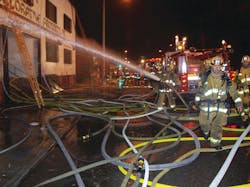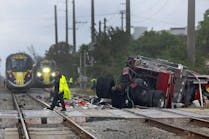Nearly half of on-duty firefighter deaths are due to overexertion. This includes deaths from heart attacks as well as heat stress. Rehabilitation should be part of any department's health and safety program, as a proper incident rehab program can help reduce adverse events to the health of the firefighters operating at the scene. The goal of the rehab sector is to let responders return to a state of readiness to operate safely during an incident.
Originally, National Fire Protection Association (NFPA) 1500, Standard on Fire Department Occupational Safety and Health Program, recommended that fire departments perform rehab services at emergency incidents. However, this standard offered little guidance on how fire departments were to carry out this recommendation. As a result, NFPA 1584, Standard on the Rehabilitation Process for Members During Emergency Operations and Training Exercises, was released in 2008 to assist with developing rehab procedures. NFPA 1584 outlines essential components to a rehab program listed in Table 1.
An incident rehab program is only one component of a health and safety program. Ensuring that members are physically fit and medically cleared to perform firefighting operations is essential to reducing adverse events for firefighters. This will reduce the chance that firefighters with medical conditions predisposing them to adverse events while performing firefighting activities are present and operating at emergency incidents. Firefighters who have higher levels of fitness also have physiologic characteristics that will allow them to adapt to and recover from the physical requirements of firefighting operations more efficiently than unfit individuals. The following offers suggestions to organize and run a rehab sector at an incident.
Relief from environmental conditions — The rehab sector must have the ability to take away environmental factors of the scene, whether it is cold or heat. This is a physical application. In general, the rehab sector should be placed away from vehicle exhaust and smoke from the incident. The rehab sector should be large enough to accommodate the members operating at the scene comfortably. It should have a defined perimeter and defined entry and exit points for accountability purposes.
During fires, we usually are concerned about heat exposure to firefighters. Placing the rehab sector in a shady area, using cooling fans or providing a climate-controlled shelter (an air-conditioned vehicle or tent) are suggestions that will give firefighters relief from heat exposure. In certain areas of the country, the opposite may be true: rehab must provide shelter from the cold. Again, this could be a heated tent or a heated bus or other vehicle requested to the scene specifically for rehab. An adjacent (non-exposed) lobby could also be used. Crew cabs can be used, but they are not ideal due to limited space.
- Rest and recovery — Firefighting is physically intense. Typical structural firefighting operations require members to exert themselves at high levels for prolonged periods. Rest is essential for firefighters to regain their strength and be able to operate efficiently and safely on the fireground. NFPA 1584 recommends a minimum of 20 minutes rest after consuming two 30-minute air bottles.
- Cooling or re-warming — This lets firefighters relieve the stress of environmental factors on their bodies. Bunker gear not only keeps heat from the environment out, it keeps heat close to the skin and when properly worn can keep heat in and raise the core temperature of firefighters. Bunker gear should be removed to let their bodies cool. Ice packs, cool water or sports drinks should be offered to help cool their bodies.
- Food and fluid replacement — Cold water should be provided at incidents. Firefighters are at risk for dehydration due to the work environment. Dehydration increases the risk of heat emergencies and can cause physical impairment to a firefighter, increasing the chance of an adverse fireground event. Additionally, when people perspire, it is not just water on their skin. Electrolytes (salt) are also excreted with water. This can cause firefighters to be at risk of electrolyte imbalances that increase fatigue. Sports drinks are an option for electrolyte replacement. If sports drinks are used, they should be diluted by half to match the physiologic electrolyte concentrations of the body. Physical labor requires energy, and energy comes from food intake. Provisions for food should be made at prolonged incidents to provide firefighters with nourishment to continue operations.
Medical monitoring and treatment — This is an important aspect of rehab, since the majority of firefighter deaths are due to overexertion. The rehab sector must be adequately staffed with personnel trained to look for physiologic signs or symptoms that a firefighter may need transport to a hospital for further medical evaluation and or treatment. This includes persistent tachycardia (heart rate greater than 120), persistent hypertension (systolic blood pressure above 140), chest pain, shortness of breath, respiratory distress, cool and clammy skin, extreme fatigue, extreme diaphoresis, altered mental status and body temperature over 100.5 Fahrenheit (see Table 2). These are all signs that the firefighter may be at risk for physiologic decompensation due to overexertion and should be transported to a medical facility.
Increased heart rate and blood pressure are a normal response to work and firefighters may have elevated blood pressures and heart rates initially during the rehab process. However, after a period of rest, the firefighters' vital signs should start to normalize and these firefighters do not need to be transported to a medical facility. Fire departments should have standardized criteria that indicate who should be transported to the hospital for further evaluation and what criteria must be met before the firefighter can return to operations (see Table 3). Qualified personnel should be in the rehab sector to treat minor injuries or have EMS transport available should members need transport to a medical facility.
- Accountability — There are two aspects of accountability regarding rehab. The first aspect is that all members are tracked on scene and assigned to the rehab sector at appropriate times. The second aspect is that rehab personnel monitor all firefighters in the rehab sector and the firefighters do not leave the sector until released. All firefighters should be monitored periodically for the need to access the rehabilitation sector. Company officers should monitor members for signs of fatigue or overexertion. Every personnel accountability report (PAR), typically 20-minute benchmarks during the incident, is an excellent reminder to assess your members. NFPA 1584 recommends that firefighters need to enter a formal rehab sector after consuming two 30-minute self-contained breathing apparatus (SCBA) bottles, after consuming one 45-minute SCBA bottle, after wearing a fully encapsulating suit or after 40 minutes of intense physical activity.
Additionally, command should ensure that a rehab sector is established and that enough resources are on scene so that operations can continue while members have adequate time in rehab. Command should ensure that all members operating at the scene are rotated through the rehab sector. For example, the Engine 1 officer notifies command that members of Engine 1 are entering the building after changing their bottles. The incident commander notes that the Engine 1 members are on their second bottles. When Engine 1 notifies command that the company is exiting the building, command will know the firefighters are due for rehab since they each have finished two bottles.
A defined entry point should be made into the rehab sector and all personnel entering the rehab sector should be documented, along with time entered and initial vital signs. This will help identify companies that have been rehabbed and companies that probably will need rehab. This also helps ensure that personnel have a sufficient period of rest, as some aggressive firefighters may try to get in and get out to continue with operations before they are appropriately recuperated.
The most important aspect of accountability in the rehab sector is that all personnel should be officially cleared for release. Vital signs and the time should be recorded for all members released from the rehab sector.
SOURCES
NFPA Technical Committee on Fire Service Safety and Health. (2008). NFPA 1584, Recommended practice on the rehabilitation of members operating at incident scene operations and training exercises.
United States Fire Administration. (2008). Emergency incident rehabilitation.
DR. RAYMOND BASRI, MD, FACP, is in the private practices of internal medicine and diagnostic cardiology in Middletown, NY. Dr. Basri is a Diplomate of the American Board of Internal Medicine and president of the Mid-Hudson Section. He received the 2008 Laureate Award of the American College of Physicians, of which he is a Fellow. Dr. Basri also is clinical assistant professor of medicine at New York Medical College, attending physician in the Department of Internal Medicine at Orange Regional Medical Center and on the consulting staff in cardiology at The Valley Hospital in Ridgewood, NJ. He is a member of the Excelsior Hook and Ladder Company in Middletown and a deputy fire coordinator for Orange County. Dr. Basri is the senior physician of the Disaster Medical Assistance Team (DMAT NY-4). He is a senior aviation medical examiner for the Federal Aviation Administration (FAA) and chief physician for Health & Safety Specialists in Medicine, which does onsite medical examinations for the fire service and consultant to FirePhysicals.com. ERIC BERGMAN, PA-C, is a physician assistant practicing internal medicine at Hartford Hospital in Hartford, CT. He earned a bachelor of science degree in allied health from the University of Connecticut and a master's degree from Albany Medical College. He is a member of the Killingworth, CT, Volunteer Fire Company; a past company officer and life member of the Avon, CT, Volunteer Fire Department; and a past member of the Shaker Road-Loudonville Fire Department in Colonie, NY.
• Relief from environmental conditions • Rest and recovery • Cooling or re-warming • Food and fluid replacement • Medical monitoring and treatment • Accountability |
• Persistent tachycardia (heart rate over 120 for greater than 10 minutes) • Persistent hypertension (systolic blood pressure greater than 140 for greater than 10 minutes) • Chest pain • Shortness of breath/respiratory distress (respirations greater than 20 for more than a 10-minute period) • Body temperature greater than 100.5 Fahrenheit • Altered mental status • Extreme fatigue • Cool, clammy skin • Extreme diaphoresis (excessive sweating) |
• Minimum 20-minute rest period • Minimum consumption of 8 ounces of water or sports drink • Normalized vital signs - Pulse 80 or lower - Systolic blood pressure below 140 - Respirations 20 or lower - Temperature 99.5 Fahrenheit or lower • Absence of other "Red Flag Signs" as listed in Table 2 |






